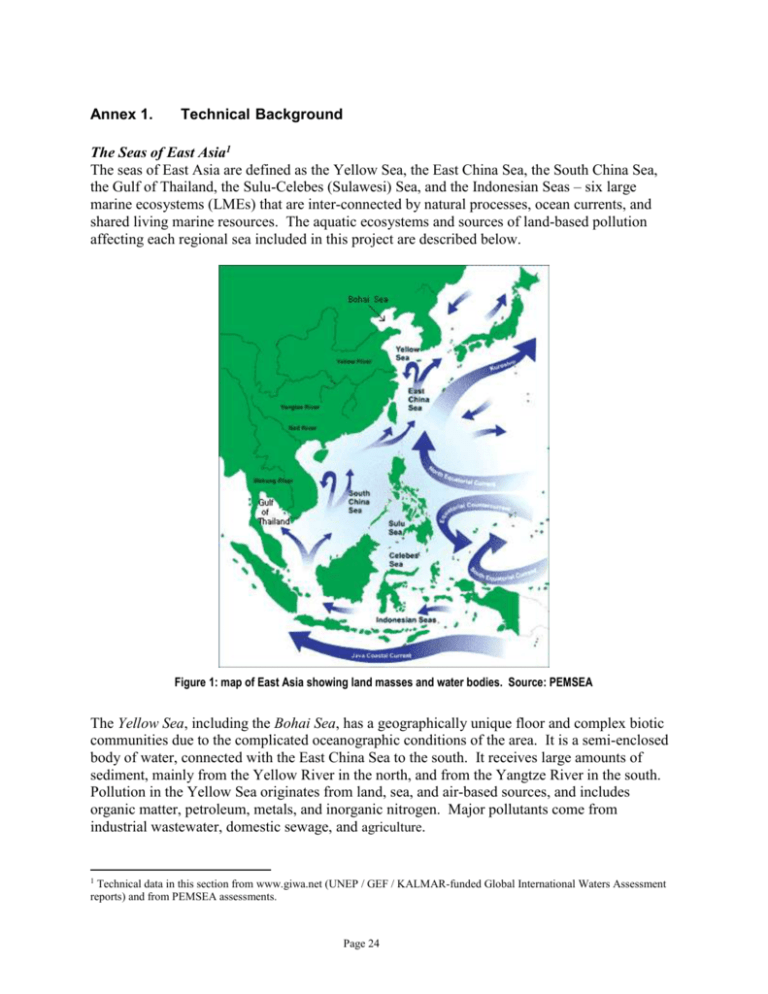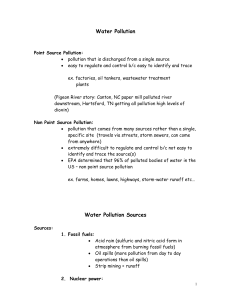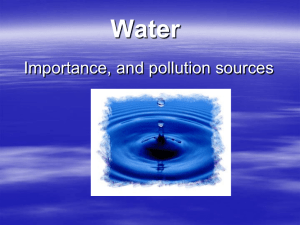09-30-05 Annex 1_FINAL - Global Environment Facility
advertisement

Annex 1. Technical Background The Seas of East Asia1 The seas of East Asia are defined as the Yellow Sea, the East China Sea, the South China Sea, the Gulf of Thailand, the Sulu-Celebes (Sulawesi) Sea, and the Indonesian Seas – six large marine ecosystems (LMEs) that are inter-connected by natural processes, ocean currents, and shared living marine resources. The aquatic ecosystems and sources of land-based pollution affecting each regional sea included in this project are described below. Figure 1: map of East Asia showing land masses and water bodies. Source: PEMSEA The Yellow Sea, including the Bohai Sea, has a geographically unique floor and complex biotic communities due to the complicated oceanographic conditions of the area. It is a semi-enclosed body of water, connected with the East China Sea to the south. It receives large amounts of sediment, mainly from the Yellow River in the north, and from the Yangtze River in the south. Pollution in the Yellow Sea originates from land, sea, and air-based sources, and includes organic matter, petroleum, metals, and inorganic nitrogen. Major pollutants come from industrial wastewater, domestic sewage, and agriculture. 1 Technical data in this section from www.giwa.net (UNEP / GEF / KALMAR-funded Global International Waters Assessment reports) and from PEMSEA assessments. Page 24 The most serious source of pollution originates from domestic, industrial and agricultural pollution discharges into the rivers that discharge to the Yellow Sea. For example, each year about 200 million tonnes of domestic sewage flows into the Yellow Sea via the Yellow and Liao Rivers. Agricultural and industrial pollution are also a problem, leading to increased concentrations of metals, pesticides, and oil in marine organisms. Dumping of solid waste (garbage, fishing gear) has increased in the region, causing public concern for recreational activities and tourism. In the Bohai Sea, whose land basin is home to 35% of China’s population, microbial pollution in seafood, although still frequent, is decreasing, partly owing to the construction of wastewater treatment facilities in large cities. However, harmful algal blooms are frequent (5 – 6 times per year) and eutrophication is considered severe. Large-scale use of pesticides and insecticides in agriculture and metals from industry has resulted in chemical pollution, with negative impacts on biodiversity. Solid waste has frequently been reported, which has been significant enough to deter the public from recreational activities on the beach around the Bohai Sea. Figure 2: Yellow Sea and Bohai Sea. Source: GIWA.net The East China Sea is important for its spawning and nursery grounds for many pelagic fish. It is bordered to the west by China, to the east by the Kuroshio Current, to the north by the Yellow Sea, and to the south by the South China Sea. It receives a large freshwater input and terrigenous sediment load from the Yangtze River. Microbial pollution is present in the sea, and harmful algal blooms have been regularly detected. The treatment capacity for domestic sewage in China’s coastal cities is only approximately 60% while the rate of sanitary disposal of household refuse is between 70 – 90%. Both of these sources of pollution have been found to cause bacterial water pollution. Since the 1980s the use of chemical fertilizers in agriculture has greatly increased, causing ubiquitous eutrophication. Page 25 The main pollutants carried to the sea by adjoining rivers are COD, nutrients, petroleum hydrocarbons, and heavy metals. In 1999, the total discharge of wastewater from Shanghai Municipality, amd Zhejiang and Fujian Provinces was 5 billion tonnes, of which 2.8 billion tonnes discharged directly into the East China Sea. Moreover, the dumping of solid waste has been on the increase; in 1999, the total domestic waste load in Shanghai reached 5 million tonnes, of which only 85% was disposed of in sanitary landfills. Industrial solid waste reached 156 million tonnes in 2000, although the percentage of this waste that reached the ocean is unknown. Figure 3: East China Sea. Source: GIWA.net The South China Sea, including the Gulf of Thailand, is known as the global center of marine shallow-water tropical biodiversity: one-fourth of the world’s coral reefs occur in this region, mangroves are found in great abundance (over 54,000 km2, or 40 % of the global mangrove area), and seagrass, which is economically important to fisheries and ecologically important to other species, is highly diverse and well represented in the area. The South China Sea is bounded to the east by the Sulu-Celebes Sea and Pacific Islands, to the south by the Indonesian Seas, to the north by the East China Sea, and to the west by the Mekong River. The health of the South China Sea is in serious decline due mainly to coastal development: the area’s rapid economic development and population growth are the cause of significant ecological damage. One of the primary environmental threats is sewage pollution, which affects biodiversity and fisheries, and has health impacts on downstream populations. Pollution, overfishing and destructive fishing practices are threatening 80% of the coral reefs in the region, and endangering seagrass habitats. In much of the region, sewage treatment is superficial at best, with raw or primary treated sewage discharged directly into water courses. Agricultural Page 26 pollution is also widespread through leaching of fertilizers and pesticides into watercourses. Pollution of Ha Long Bay (Vietnam) threatens coral reefs, marine life, and the livelihood of hoteliers and fishermen. In 10 years, 900 million tonnes of sediment polluted by coal mining have been transported by rivers into the Bay, and close to 9 million m3 of industrial wastewater contaminated by lead and petrol is discharged into the Bay every year. In Indonesia, municipal and industrial wastewater is discharged virtually untreated into the waterways causing rapid deterioration in the quality of river water. Eutrophication hotspots occur in the vicinity of coastal cities and estuarine areas in non-urban settings where sewage or industrial discharges are directly dumped because of the lack of sewer connections to centralized sewage treatment facilities. This is commonplace in Indonesia, Vietnam, and the Philippines. Finally, solid waste (garbage, litter on beaches) has given rise to public concern regarding recreational use and tourism. Figure 4: South China Sea. Source: GIWA.net The Sulu-Celebes (Sulawesi) Sea area is one of the world’s most biologically diverse marine environments. It lies within the global centre of biodiversity for both terrestrial and marine species with, for example, more than 400 species of reef-building corals, and 2,500 species of marine fishes. It contains most of the Philippines islands (excluding the northern islands), the Page 27 northernmost islands of Indonesia, and Malaysian Sabah. In the major urban centers, sewage treatment is superficial at best, with raw sewage discharged directly into water courses. Agricultural pollution is also widespread through leaching of fertilizers and pesticides. Microbial pollution is significant in major urban centers, originating from inadequate sewage disposal and treatment, which has affected fisheries and human health. The production of wastewater in the Manila region is estimated at 74 million m3 in 1994, while the volume of treated wastewater reached just 10 million m3. Eutrophication, although localized, has caused some paralytic shellfish poisoning in parts of the region. Solid waste has caused moderate environmental impact in the region. However, there has been severe impact locally, particularly around the larger cities, where waste management is either poor or non-existent. There is widespread litter on beaches, high frequencies of benthic solid waste recovery by trawlers, and frequent reports of entanglement / suffocation of marine species by solid waste. Figure 5: Sulu-Celebes (Sulawesi) seas. Source: GIWA.net Finally, the Indonesian Seas are important because they support an extremely high biological diversity, including both demersal and pelagic fisheries, sharing highly migratory fish resources (tuna, mackerel, round scad) with adjacent countries. The Indonesian Seas encompass most of the 18,000 islands of the republic of Indonesia, bounded on their western and northern extent by Page 28 the Bay of Bengal, South China Sea, and Sulu-Celebes (Sulawesi) Seas; on their southern extent by the north Australian shelf; and northeastern extent by Pacific islands. Urban expansion and industrialization have resulted in water pollution from industry, sewage, and contaminated air. Municipal and industrial wastewater is discharged virtually untreated into the waterways causing rapid deterioration of water quality, particularly in the large urban centers (e.g. Jakarta, Surabaya). Total discharges of organic water pollution have experienced a rapid increase from 214 tonnes per day in 1980 to over 537 tonnes per day in 1993. Toxic algal blooms have caused paralytic shellfish poisoning, and shellfish from most of the Java Sea are no longer eaten. Eutrophication has severe local impacts e.g. in the Jakarta Bay, where massive blooms of phytoplankton several meters thick are present for several kilometers offshore. Overall, solid waste poses a severe problem, particularly in the Java Sea and around cities where waste management is unable to keep pace with production. Massive amounts of plastic bags and other waste products flow into Jakarta Bay and foul the Pulau Seribu islands; plastic and other floating wastes wash ashore on many beaches and clog outboard motors of boats. Figure 6: Indonesian Seas. Source: GIWA.net Page 29







